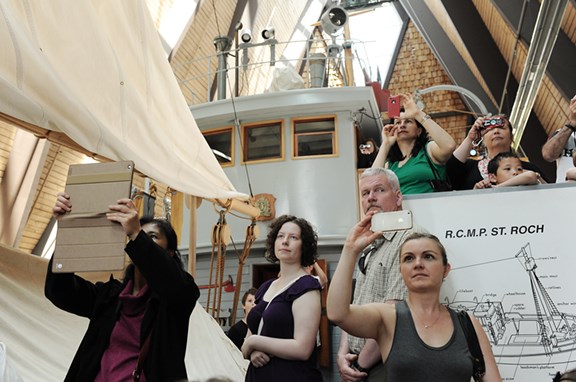Rolled maps, wood skis, an RCMP serge hanging off the bed — everything is as it was in captain Henry Larsen’s cabin aboard the St. Roch circa 1944. On the deck is a recreation of a tent where Inuit guide Joe Panipakuttuk lived with his family, a lively combination that included a wife and baby, a mother-in-law and 17 dogs.
The RCMP schooner has been “docked” under the glass and wood triangle shelter of the Vancouver Maritime Museum since the vessel was designated a National Historic Site in 1962. But its illustrious history — which includes being the first ship in the world to sail the Northwest Passage from west to east (1940-1942) and the first to circumnavigate North America (1950) — is not too distant to discover living ties.
Retired RCMP Staff Sergeant Dan Lemieux was stationed in the ship’s engine room during Saturday’s Raise the Sails and Ring the Bell ceremony, which is the first time the ship has been open to the public in two years during which time the shelter was restored.
“Everybody thinks I was the captain of this ship but I wasn’t. I am 19 days older than the St. Roch,” said Lemieux between greeting those who made their way through the narrow corridor of engine pipes and tanks.
It’s easy to see why some might assume Lemieux was part of the crew as he has lectured on the topic of the St. Roch since 1952 — longer than the ship saw water.
While the St. Roch is known for its historical firsts, it was a crucial part of asserting Canadian sovereignty in the arctic, serving as a supply vessel for the four RCMP detachments in the western arctic from 1928 to 1948.
When the ship was frozen in the ice, Lemieux explained, it became a regular detachment thanks to its rugged hull. (The egg-shaped design served well in the ice but was so lively at sea it made everybody but the captain seasick. Even Panipakuttuk, who was no stranger to travelling waters, was reportedly horrified by the ship’s sea-keeping abilities.)
The floating detachment’s list included “investigating crimes including 17 murders, settling domestic and other disputes, taking census, rendering first aid, searching for missing Inuit and providing weather reports.”
The RCMP members built igloos every night for shelter, even wearing Inuit clothing as their uniforms weren’t enough to protect them from the severe cold. “It was a hard lifestyle out there, the conditions were so harsh,” said Lemieux. “And these were farm boys. It was during the Depression so they were just happy to have a job.”
The schooner was built in Burrard Ship Yards at the bottom of Lonsdale in North Vancouver in 1928 and that connection brought out Ted Bavey to volunteer at the ceremony. His uncle, who grew up in Kitsilano, built some of the St. Roch’s cabinetry.
Others had more mischievous connections. William Crayford, otherwise known as “Bare Knuckle Bill,” was present in the form of actor Dylan Coulter for Saturday’s ceremony. He was reportedly found recently after being separated from the St. Roch and lost in the Arctic for 70 years. The tale was so compelling many national media picked it up not noticing the dateline of April 1.
Museum executive director Ken Burton is eager to keep the real stories of the St. Roch alive, mentioning that he would love to see the ship commemorated on a coin, particularly for its role in rescuing 12 people from a sinking Hudson’s Bay Company schooner in 1937.
“You know what the coin did for the Bluenose, the dime,” he told the crowd. “We’re shooting for a toonie, I think!”
Burton said the St. Roch is a true reflection of the country it served.
“This is a unique Canadian vessel. It has lived through tough times,” he said. “This is a vessel that was built right here in British Columbia, it was crewed by farm boys from all across Canada, it was named for a parish in Quebec, it was skippered by an immigrant, and successful in the far north with the help of the Inuit.”



